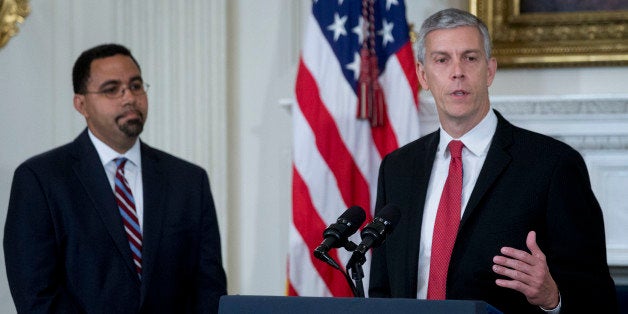
U.S. Secretary of Education Arne Duncan recently proposed to redirect $15 billion from correctional facilities toward increasing teachers' salaries in high poverty schools.
Unfortunately, because his suggestion came just days before he announced his resignation, this proposal risks being dismissed as some kind of a Hail Mary; an attempt to be provocative on his way out the door. He even suggested as much, when he stated "I want to lay out an idea today that will strike some as improbable or impractical."
Actually, his idea is neither.
It is both practical and eminently plausible. With the right kind of leadership and advocacy, it might even become probable.
Its basic premise -- that increased investments in education in high poverty schools will reduce crime and improve public safety -- is backed up by a solid and growing body of research. Duncan outlined some of this in his speech, citing a study by economist Lance Lochner that a 1 percent increase in male high school graduates will result in 100,000 fewer crimes and a savings of $1.4 billion annually. But there is more.
According to Lochner, the greatest reductions in crime from increasing the number of high school graduates will be in the categories of murder, assault and motor vehicle theft. Another economist, Hank Levin, found that the average criminal justice-related savings per new high school graduate is $26,600, almost twice that for black males.
Sociologist Bruce Western calculated the risk of imprisonment for black high school dropouts born between 1975 and 1979 at 68 percent. That percentage drops to 21 percent for those with a GED, and to 6% for those with college degrees.
As Duncan stated, "You don't have to be a liberal romantic to like the idea of investing up front in our kids. A hard-nosed look at the bottom line will take you to the same place."
Moreover, this is not exactly a new idea.
The Ella Baker Center launched "Books Not Bars" back in 2004. In 2011, the NAACP unveiled its Smart and Safe Campaign aimed at redirecting "misplaced priorities" that under-educate and over-incarcerate. A hybrid of Duncan's proposal, in the form of Proposition 47, passed in 2014 in California. Massachusetts has introduced An Act to Increase Neighborhood Safety and Opportunity, which calls for repealing mandatory minimums, changing certain felonies into misdemeanors and redirecting savings to, among other things, drop-out prevention and recovery. Undoubtedly other states are putting forth similar legislation and ballot initiatives.
In fact, Duncan's proposition should not only be taken very seriously, but expanded to encompass a wider range of educational reinvestment targets. As worthy as increasing teacher pay is, there are other options from which legislators and the public might choose. In order to increase graduation rates, high poverty schools need more restorative justice and less zero tolerance -- more counselors and fewer police roaming the halls.
Robert Balfanz, a noted dropout expert, has called the middle and high school years for at-risk youths "make or break." He cites the 9th grade transition to high school as particularly treacherous for struggling students.
So, in addition to investing in higher pay for teachers, funds saved by reducing our nation's prison population could be redirected into trauma-sensitive training for teachers and administrators, additional health and mental health services in schools, or into special 9th grade interventions for students flirting with dropping out.
For those students who have already dropped out, or are court-involved, there are programs -- like YouthBuild, ROCA, and Teen Equality Center -- that offer second chances, intensive supports, vocational training, and opportunities to finish high school. Recidivism rates for youths who go through these programs are exceedingly low.
What is important to remember is that all of us benefit from this kind of reinvestment approach. As Lochner and his colleagues wrote, "The social return to schooling is larger than the private return."
This is one instance when doing "good" (investing in educating our population instead of caging them) is the same as doing well (making our society safer and more prosperous). The public increasingly understands this. It has moved a long way from the "tough on crime" heyday of the 1980s and 1990s.
The bi-partisan coalition to dismantle mass incarceration continues to grow. Reinvesting funds saved from a smaller criminal justice system into effective educational interventions for young people at risk of dropping out, or who are disconnected from both school and work, is an achievable and practical next step.
All we need to make it a probable one is the political will, which will come through bold leadership, a willingness to take on the predictable opponents, and aggressive, effective advocacy.